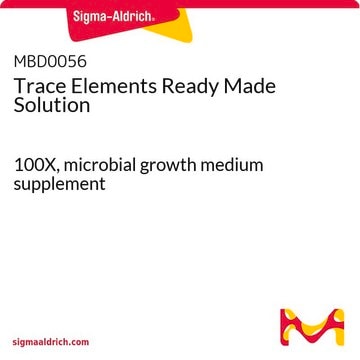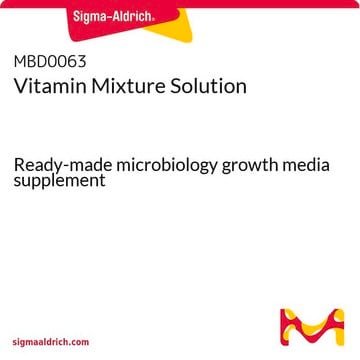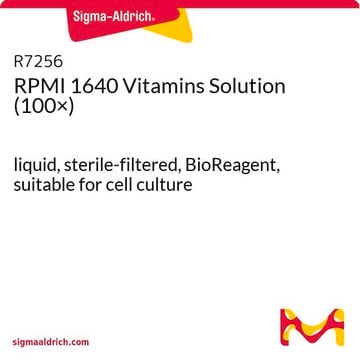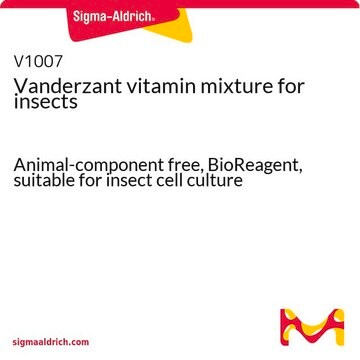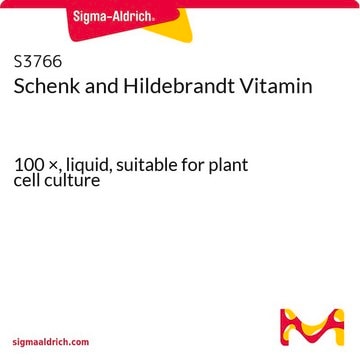B6891
BME Vitamins 100x solution
BioReagent, sterile-filtered, suitable for cell culture
Synonym(s):
Vitamins mixture
Sign Into View Organizational & Contract Pricing
All Photos(1)
About This Item
Recommended Products
sterility
sterile-filtered
product line
BioReagent
form
liquid
technique(s)
cell culture | mammalian: suitable
color
yellow to dark yellow
shipped in
dry ice
storage temp.
−20°C
Looking for similar products? Visit Product Comparison Guide
Application
BME Vitamins 100x solution has been used as a component of M9 minimal medium for 15N-labeled protein expression. It has also been used as a supplement in neurobasal-A medium for organotypic hippocampal cultures.
BME Vitamins 100x solution is used in MOPS modified medium (MMM). It has been used as a supplement in several growth media.
related product
Product No.
Description
Pricing
Storage Class Code
12 - Non Combustible Liquids
WGK
WGK 1
Flash Point(F)
Not applicable
Flash Point(C)
Not applicable
Personal Protective Equipment
dust mask type N95 (US), Eyeshields, Gloves
Certificates of Analysis (COA)
Search for Certificates of Analysis (COA) by entering the products Lot/Batch Number. Lot and Batch Numbers can be found on a product’s label following the words ‘Lot’ or ‘Batch’.
Already Own This Product?
Find documentation for the products that you have recently purchased in the Document Library.
Customers Also Viewed
Rebecca J Edgar et al.
Nature chemical biology, 15(5), 463-471 (2019-04-03)
Cell wall glycopolymers on the surface of Gram-positive bacteria are fundamental to bacterial physiology and infection biology. Here we identify gacH, a gene in the Streptococcus pyogenes group A carbohydrate (GAC) biosynthetic cluster, in two independent transposon library screens for
Alex P Lundin et al.
Journal of bacteriology, 202(9) (2020-02-20)
Bacterial microcompartments (MCPs) are widespread protein-based organelles composed of metabolic enzymes encapsulated within a protein shell. The function of MCPs is to optimize metabolic pathways by confining toxic and/or volatile pathway intermediates. A major class of MCPs known as glycyl
Jens Jakob Sigurdarson et al.
MicrobiologyOpen, 9(3), e976-e976 (2020-01-17)
The enzyme urease is widespread in nature and catalyzes the hydrolysis of urea to form ammonia and carbonic acid. The high proficiency of the enzyme is associated with a wide range of societal challenges. In agriculture, bacterial urease activity leads
Anaïs M E Cassaignau et al.
Nature protocols, 11(8), 1492-1507 (2016-07-29)
During biosynthesis on the ribosome, an elongating nascent polypeptide chain can begin to fold, in a process that is central to all living systems. Detailed structural studies of co-translational protein folding are now beginning to emerge; such studies were previously
Micah Steffek et al.
Biochemistry (2022-01-06)
Autophagy-related proteins (Atgs) drive the lysosome-mediated degradation pathway, autophagy, to enable the clearance of dysfunctional cellular components and maintain homeostasis. In humans, this process is driven by the mammalian Atg8 (mAtg8) family of proteins comprising the LC3 and GABARAP subfamilies.
Our team of scientists has experience in all areas of research including Life Science, Material Science, Chemical Synthesis, Chromatography, Analytical and many others.
Contact Technical Service

